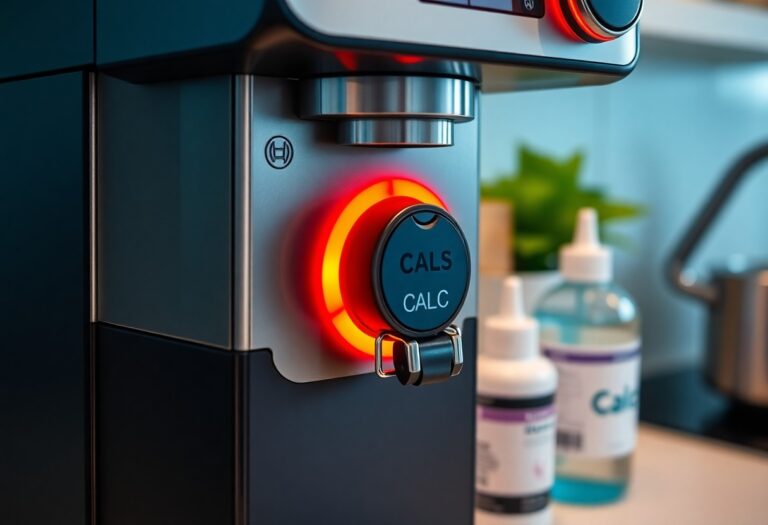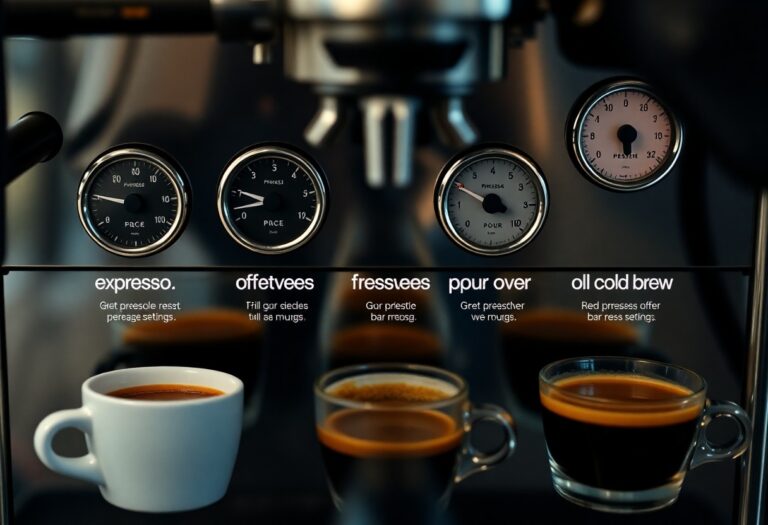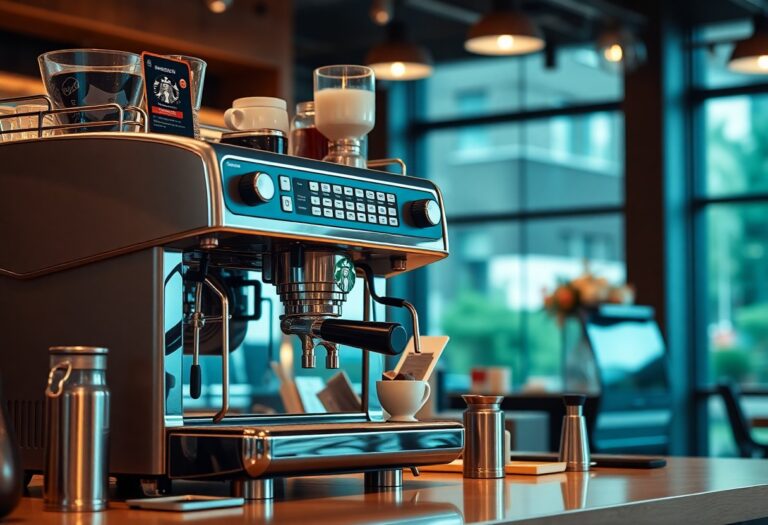What Grind Coffee for an Espresso Machine – Grinding Guide
You need to understand the importance of grind size when it comes to brewing the perfect espresso. A consistent, fine grind is necessary for optimal extraction, allowing your machine to work its magic and produce rich, flavorful shots. Using the right grind can enhance your coffee’s aroma and taste, while a poor grind can lead to bitter or weak espresso. For comprehensive insight, check out this Espresso Grind – Choosing the Right Size guide to help you master your espresso game.
Key Takeaways:
- The grind size for espresso should be fine, similar to powdered sugar, to ensure optimal extraction during brewing.
- Use freshly roasted beans and grind them just before brewing to enhance flavor and aroma.
- Different espresso machines may require slight adjustments in grind size for the best results, so experimentation is key.
- Consistent grind size is vital for uniform extraction, which helps prevent under-extraction or over-extraction of flavors.
- Investing in a high-quality burr grinder is recommended for precise and consistent coffee grounds.

The Science of Espresso: Grinding vs. Brewing
Espresso brewing is a dance between precise grinding and effective extraction. The quality of your espresso is heavily influenced by how well you grind your beans. A perfect grind provides a uniform particle size that interacts efficiently with hot water, leading to the extraction of rich flavors and aromas. If not executed properly, you can easily end up with a bitter or sour shot, undermining that delightful coffee experience you seek. Understanding the intricate relationship between grinding and brewing is imperative in your espresso journey.
The Role of Particle Size in Flavor Extraction
Particle size plays a pivotal role in flavor extraction during espresso brewing. Finer grinds increase the surface area exposed to water, allowing for quicker extraction of oils, acids, and sugars. This creates a more intense flavor profile. However, if the grind is too fine, it can lead to over-extraction, resulting in bitterness. Conversely, larger particles will slow down extraction, potentially leading to a flat and underwhelming taste.
How Grind Consistency Affects Coffee Quality
Consistency in grind size is vital for achieving a balanced espresso. Inconsistent particles lead to uneven extraction; some coffee grounds may be over-extracted while others are under-extracted. This variance creates an unpredictable flavor profile, often resulting in a disappointing cup. Fine tuning your grind with a high-quality burr grinder helps ensure each particle is uniform, delivering a smooth and rich taste with every shot.
For instance, using a grinder that delivers a mix of sizes can disrupt the harmony of flavors you aim to achieve. If you think about it in terms of brewing time, a consistent grind allows for a standard extraction time—ideally around 25-30 seconds for a shot of espresso. When you consistently grind your beans to the suitable size, you can control brewing variables more effectively, enhancing the overall quality of your espresso by ensuring that water interacts evenly with your grounds. This level of precision allows you to enjoy a vibrant cup, with all the nuanced flavors properly balanced and fully expressed.
Choosing the Right Grinder for Espresso Excellence
A high-quality grinder is crucial for achieving espresso excellence, as it directly affects the flavor and extraction of your coffee. Look for a grinder that offers uniform particle size, as inconsistent grind can lead to uneven extraction and a less-than-ideal espresso shot. Prioritize grinders designed specifically for espresso, as they often feature precise adjustments to help you dial in the perfect grind for your machine and beans. Those who take their espresso seriously will find that investing in a reliable grinder pays off in the long run.
Burr vs. Blade: The Best Option for Espresso
Burr grinders outperform blade grinders when it comes to espresso, as they produce a consistent grind size crucial for optimal extraction. Burr grinders utilize two revolving surfaces to crush beans evenly, avoiding the uneven particle sizes that blades tend to create. This precision results in a more controlled brewing process, ultimately leading to a richer and more flavorful espresso. Investing in a quality burr grinder is a step towards espresso mastery.
Essential Features to Look for in an Espresso Grinder
Choosing an espresso grinder involves considering specific features that enhance performance. Look for options with multiple grind settings, as versatility can accommodate various coffee types and personal preferences. A doser or doserless design allows for accurate portioning, while a hopper with a tight seal preserves freshness. Additionally, a grinder equipped with a low RPM motor minimizes heat generation, which helps maintain the integrity of the coffee oils, ensuring a superior flavor profile. Prioritize grinders with solid build quality for longer-lasting durability.
For the best results, you should focus on several crucial features while selecting your espresso grinder. A multiple grind setting capability allows you to customize the consistency for different beans and extraction methods, tailoring each dose to your taste preferences. A doserless model enables you to dispense exactly the right amount for single servings, promoting freshness and minimizing waste. Low RPM motors are crucial for reducing heat during the grind, preventing flavor degradation, while durable materials ensure that your investment withstands heavy use. Each feature contributes to producing high-quality, barista-worthy espresso shots.

Mastering Grind Size: Achieving the Perfect Texture
Finding the right grind size is a delicate balance that can significantly impact your espresso’s flavor and extraction quality. A texture that’s too fine can lead to over-extraction, resulting in a bitter taste, while too coarse might lead to under-extraction, yielding a sour brew. The goal is to achieve a consistent, fine texture, much like granulated sugar, that enables the water to flow through the coffee grounds evenly. Mastering this element allows you to unlock the full potential of your coffee’s flavor profile and aroma.
Fine vs. Coarse: What’s the Ideal Size for Espresso?
The ideal grind size for espresso is distinctly fine, resembling table salt or granulated sugar, allowing for maximum surface area exposure. A fine texture not only aids in the quick extraction process but ensures the rich and complex flavors characteristic of a well-pulled espresso shot shine through. Coarser grinds will result in quicker extraction, thus leading to a weak and uneven shot that lacks depth.
How to Adjust Grind Size for Different Beans
Adjusting grind size based on the type of beans you’re using is a key step in perfecting your espresso game. Factors such as bean origin, roast level, and freshness all influence how your espresso extracts. For instance, darker roasts tend to extract faster and may require a slightly coarser grind, while lighter roasts benefit from a finer grind to enhance their more delicate flavors. Always taste your espresso—if it’s too bitter or sour, adjust the grind size a notch accordingly until you hit that sweet spot in flavor balance.
When adjusting grind size for different beans, keep in mind that freshness plays a significant role. As coffee beans age, their properties change, affecting extraction. Freshly roasted beans often require a finer grind to capture their brightness, while older beans may need a coarser grind to prevent over-extraction. Additionally, beans from various regions have unique flavor profiles that can also dictate your grind settings. For example, beans from Colombia may highlight fruity notes that benefit from a finer grind, while earthy Indonesian beans may need adjustment towards coarser settings. Considering these nuances will help you create the perfect espresso tailored to your chosen beans.
Common Grinding Mistakes: What to Avoid
Many coffee enthusiasts overlook the importance of the grinding process, leading to disappointing espresso. Avoiding mistakes such as inconsistent grind size and using stale beans can significantly enhance your brewing experience. Learn more about this and how to fix these issues in A Coffee Lover’s Guide on How to Grind Coffee Beans for Espresso.
Neglecting Freshness: The Impact of Stale Coffee
Stale coffee beans can ruin your espresso shot before you even start brewing. As coffee sits, it loses its rich flavors and aromas due to oxidation. Ideally, you should use freshly roasted beans, preferably within two to four weeks of roasting. Grinding stale beans leads to a flat, lifeless cup, negating the efforts you put into perfecting your espresso technique.
Over or Under Grinding: Signs and Solutions
Identifying whether you’ve over or under-grinded your coffee is straightforward. If your espresso shots are extracting too quickly, resulting in a watery taste, your grind size is too coarse (under grinding). Conversely, if your shots take forever to extract and taste bitter, your grind size is too fine (over grinding). Adjusting your grinder settings is key to achieving the perfect balance and flavor profile in your espresso.
In practice, you should aim for a fine, consistent grind that resembles granulated sugar. If your espresso has sour notes, it might be under-extracted due to a too-coarse grind; dial in to a finer setting. On the flip side, if you taste bitterness or over-extraction, coarsen your grind a notch. Keeping track of your adjustments and experimenting slightly with grind size can significantly enhance the complexity of your espresso shots, leading to a more enjoyable brewing experience.
Coffee Bean Selection: The Perfect Match for Your Grind
Choosing the right coffee beans sets the foundation for a stellar espresso experience. Focus on varieties known for their distinct flavor profiles, such as Arabica for its sweetness and acidity or Robusta for its rich, bold taste and crema-enhancing properties. Experiment with single-origin beans from regions like Yirgacheffe or Sumatra to uncover unique flavor notes that pair with your grind. Seasonal freshness plays a significant role too, as beans harvested recently usually yield better flavor, enhancing your espresso adventures.
Bean Profiles: Optimizing Flavor with the Right Grind
Each coffee bean possesses its own unique flavor profile influenced by factors such as origin, processing method, and roast level. For example, light roasts typically showcase brighter acidity and fruitiness, while dark roasts offer deeper, bolder flavors. Adjusting your grind size to complement these profiles can amplify specific flavors; a fine grind tends to highlight sweetness, while a coarser grind may emphasize body and depth. Ultimately, aligning your grind with the bean’s characteristics unlocks its full flavor potential.
Seasonal Trends: How to Choose Beans for Espresso
Staying attuned to seasonal trends can elevate your espresso experience. Certain beans shine at different times of the year, influenced by harvest cycles and flavor development. As new crops become available, you might notice freshness in flavor profiles, especially in single-origin options. During spring and summer, fruity, floral beans can provide a refreshing cup, whereas fall and winter may call for richer, spicier selections.
Monitor specialty coffee releases and seasonal offerings from your favorite roasters to discover standout beans that enhance your espresso routine. Many roasters identify specific harvest peaks, allowing you to enjoy fresher beans with distinct flavor nuances. Your exploration might lead to limited-edition releases capturing the essence of the season, transforming your espresso experience and offering a delightful variety throughout the year. Embrace these seasonal trends to keep your coffee experience dynamic and exciting!
Conclusion
So, when you grind coffee for your espresso machine, focus on achieving a fine, consistent grind that enhances flavor extraction during brewing. Experiment with your grind size and adjust based on your espresso’s taste profile. Always use fresh, high-quality beans and consider the grind settings of your specific machine. By mastering your grinding technique, you’ll elevate your espresso experience and impress with each shot you pull.
FAQ
Q: What grind size is ideal for an espresso machine?
A: For espresso machines, a fine grind size is ideal. The coffee grounds should resemble granulated sugar in texture. This fine consistency allows for optimal extraction of flavors during the short brewing time of espresso, ensuring a rich, concentrated shot.
Q: How do I determine the right grind for my specific espresso machine?
A: The right grind can vary based on the type of espresso machine you are using (manual, semi-automatic, fully automatic). It’s best to start with a fine grind and adjust based on the flow rate of the espresso. If the coffee drips too quickly, try a finer grind. If the flow is too slow or produces bitter flavors, opt for a coarser grind.
Q: Can the type of coffee bean affect the grind size needed?
A: Yes, the type of coffee bean can influence the grind size. Different beans, depending on their roast level and density, may require slight adjustments to the grind. For instance, lighter roasts might benefit from a slightly finer grind to enhance extraction, while darker roasts might require a slightly coarser grind to avoid over-extraction.
Q: How often should I adjust the grind size for espresso?
A: It’s advisable to adjust the grind size based on consistency and taste. If you notice changes in the flavor of your espresso or fluctuations in brewing time, it may be time to adjust the grind. Environmental factors such as humidity and bean freshness can also impact the ideal grind size, so keep an eye on your results and adjust when necessary.
Q: What tools can I use to achieve the perfect grind for espresso?
A: A quality burr grinder is recommended for espresso grinding. Burr grinders provide a more consistent grind compared to blade grinders, which can create uneven particle sizes. Look for grinders that allow you to adjust the grind settings precisely to suit your espresso machine’s requirements.







